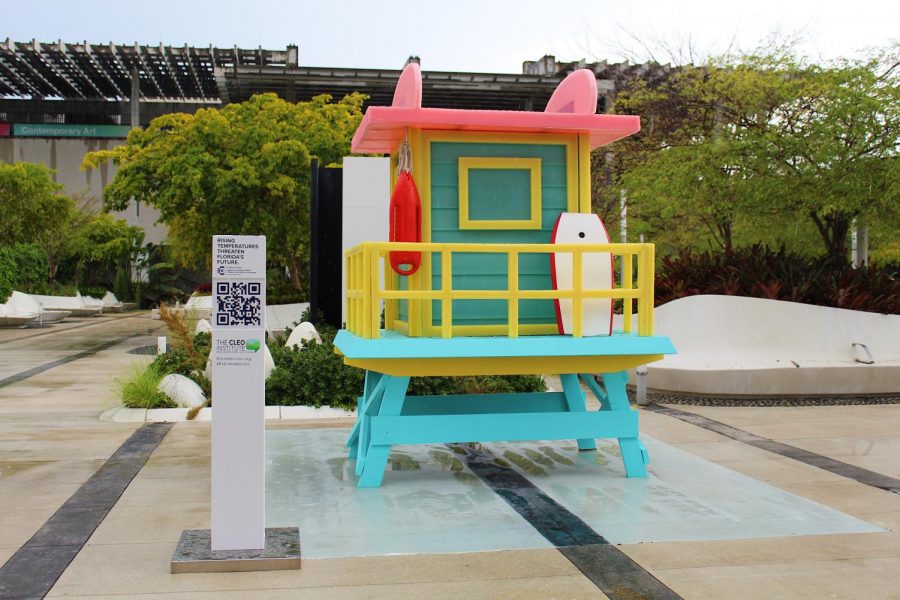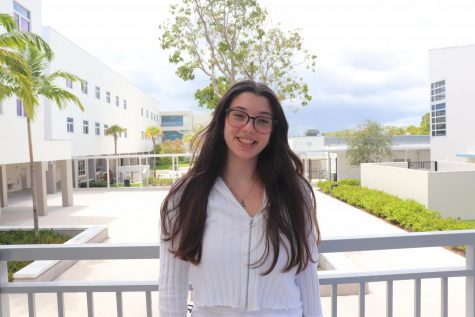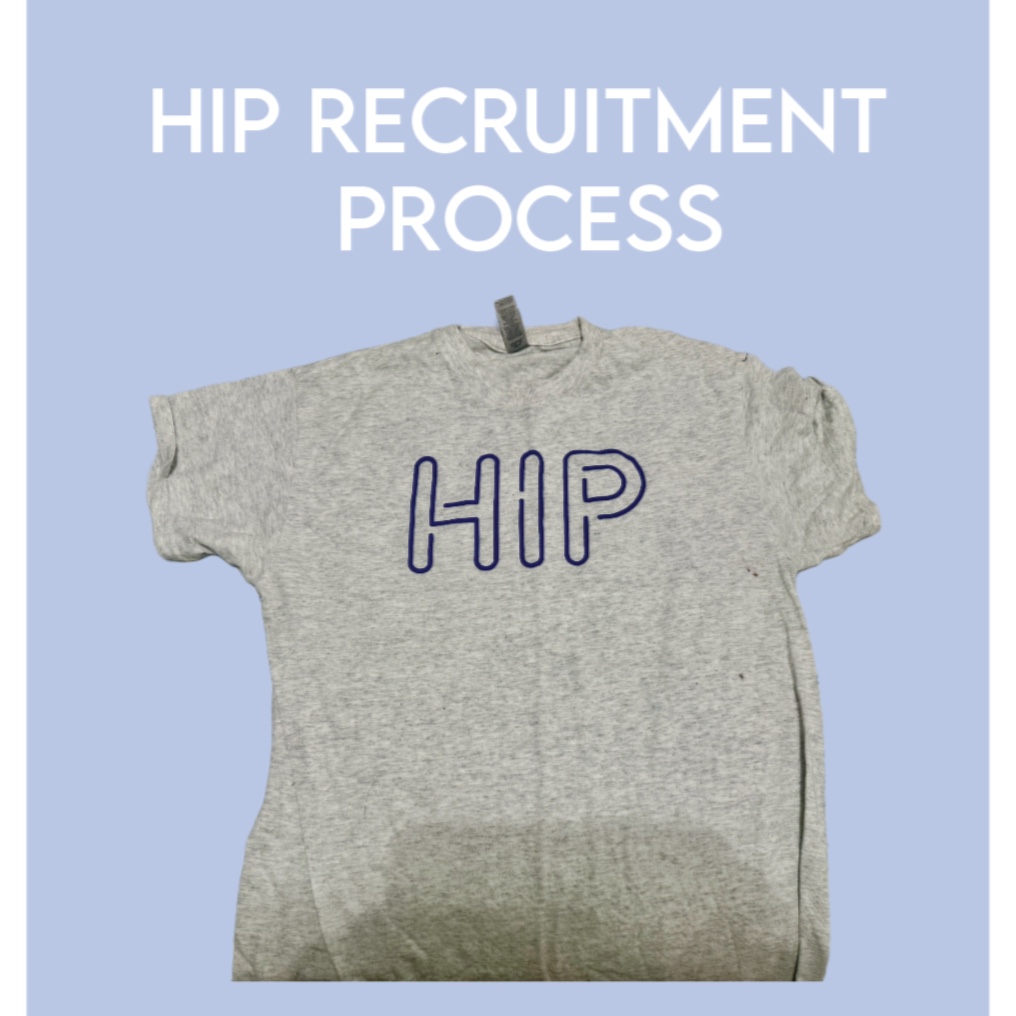New Campaign at FROST Museum Highlights Causes of Climate Change
A wax replica of a lifeguard tower located at the FROST Museum set to melt over 4-5 days, representing the effects climate change will have to Florida.
September 12, 2020
On Wednesday, Sep. 9 , The CLEO Institute, in collaboration with Zubi Advertising, launched the #FLClimateCrisis campaign seeking to raise awareness surrounding the impacts of climate change in Florida. The campaign features biodegradable wax sculptures created by Bob Partington in three locations — Miami, Tampa and Orlando — which will melt over the course of four to five days.
At the FROST Science Museum, a sculpture of a lifeguard hut was unveiled representing Miami’s economic dependency on tourism and how climate change has weakened that economic powerhouse. According to Miami-Dade County, Miami-Dade is the “leading center for tourism” in Florida, providing $18 billion for the local economy in 2018.
Climate change, however, poses significant impacts to that immense source of revenue. In 2017, Hurricane Irma led to a 206,900 drop in visitors during the month of Sept. 2017 when compared to September 2016 according to Miami-Dade County. A 2018 paper published by the National Center for Atmospheric Research addressed the link between increasing ocean heat content and hurricanes and said that the increased moisture in a storm leads to higher precipitation, storm intensity, and storm growth.
“The economic impacts in Florida will be hundreds of billions of dollars in the coming years. This includes the cost of hurricanes. Hurricane Irma cost the state around $50 billion,” Communications Coordinator of the Volo Foundation Stephanie Ortega said. “We are the last generation that can do something about it.”
Due to climate change, it is projected that hurricanes will increase in intensity and in turn, damage Floridians and the economy. In a 2018 study by the Journal of Climate, HiFLOR simulations found that in the early 21st century, tropical cyclones are expected to exceed wind speed of category 5 storms and as such the Saffir–Simpson scale might need to include higher intensities.
“We have got to have leadership that understands that when I go out on my balcony at night, and I run into a wall of heat, that makes it impossible to even sit down and enjoy the view of Biscayne Bay that I have. It really reeks of what the future might look like and feel like,” CLEO Institute Founder Caroline Lewis said. “We are looking at a tempest in a teacup, and we’re saying more heat, less wildlife, more heat, less health, more heat, less beach.”
The melting of the wax statues also serves to illustrate the intense heat Florida faces. In June, Miami saw the hottest week ever recorded, according to Local 10 News. By 2050, Miami-Dade residents can expect to live half the year in “danger days” where the heat index is above 105 degrees, according to a study by The Union of Concerned Scientists.
In Miami, the effects of this heat have already become tangible with the recent events occurring in Biscayne Bay. Heat was a leading factor in the low dissolved oxygen levels leading to a massive fish kill in the Bay, according to the Miami Herald.
High temperatures can also be attributed to the algae blooms occurring in the Bay. According to the EPA, climate change — specifically higher temperatures — serve as a catalyst for the formation of algae blooms.
“The biggest obstacle we face to addressing climate in Florida is political. It’s the unbelievably low bar to action that has been put in place by leaders that have been either hostile or failed to act whatsoever with respect to climate,” Democratic Senator Jose Javier Rodriguez said.
According to Florida Climate Pledge, 22 of the top 25 cities most susceptible to coastal flooding today in the United States are located in Florida. However, as of 2018, according to the US Energy Information Administration, Florida ranks 32 in national renewable energy consumption, with natural gas accounting for 73.7 percent of the state’s net energy generation.
“If you want to make change as a community, there’s a lot of ways of doing that. There’s a lot of examples in my district of young people who… have made issues about texting and driving and other things and they’ve gone and spoken at commission meetings, organized events or been active on social media to try to help the environment… There’s a million things that you can do,” Rodriguez said. “The most powerful message is to remind people like I have two young sons…. They can’t vote. So that makes it much more urgent for me to vote, as I’m voting on their behalf.”
In Miami, youth activists have vocalized their concerns through climate strikes, attending public city commissioner meetings and communicating with public officials. After a youth-organized climate strike in front of Miami Beach City Hall — which mobilized over 200 residents — the City of Miami Beach unanimously voted to pass a climate emergency.
Similarly, the City of Miami passed a climate emergency in November, pressured by youth who had been protesting since June 2019. Coral Gables also passed a climate emergency in January after youth, specifically from the Miami Chapter of Fridays For Future Miami and Extinction Rebellion Miami, had protested every Friday since November. The cities of Palmetto Bay and Surfside followed suit, pressured by youth voices from Gen CLEO, Sunrise Movement Miami, Fridays For Future Miami, Florida Climate Strike and Extinction Rebellion Miami.
“It is time to wake each other up, including our elected officials and unite under science. It is now time to take back our future and transform this crisis into an opportunity to rebuild, reunify and reverse the effects that this climate crisis has already brought and will continue to bring to the face of every living thing on this planet,” Palmetto Alumna and CLEO Institute Intern Nicole Gazo said.
If you are interested in becoming involved in climate action you can:
- Register or pre-register to vote: Vote for a political candidate who realizes this is an issue and is willing to take measures to address it. If you are 16, you can pre-register to vote in Florida.
- Spread awareness regarding the climate crisis on social media: Use the #FLClimateCrisis campaign when visiting the statue at the FROST Museum and share the meaning behind it.
- Advocate for climate action: If you are unable to vote, get involved with local environmental organizations that seek climate action, such as Fridays For Future Miami, Extinction Rebellion, Florida Climate Strike, 350 South Florida, The Sunrise Movement and the CLEO Institute.
- Volunteer at a polling station: Due to seniors being affected by Covid-19, there is a huge need for volunteers at polling stations.
- Join the Climate Leadership Information Project program at Palmetto: CLIP advocates for climate action, contacts elected officials, educates our peers and families about the climate crisis and seeks to create meaningful change at Palmetto.










